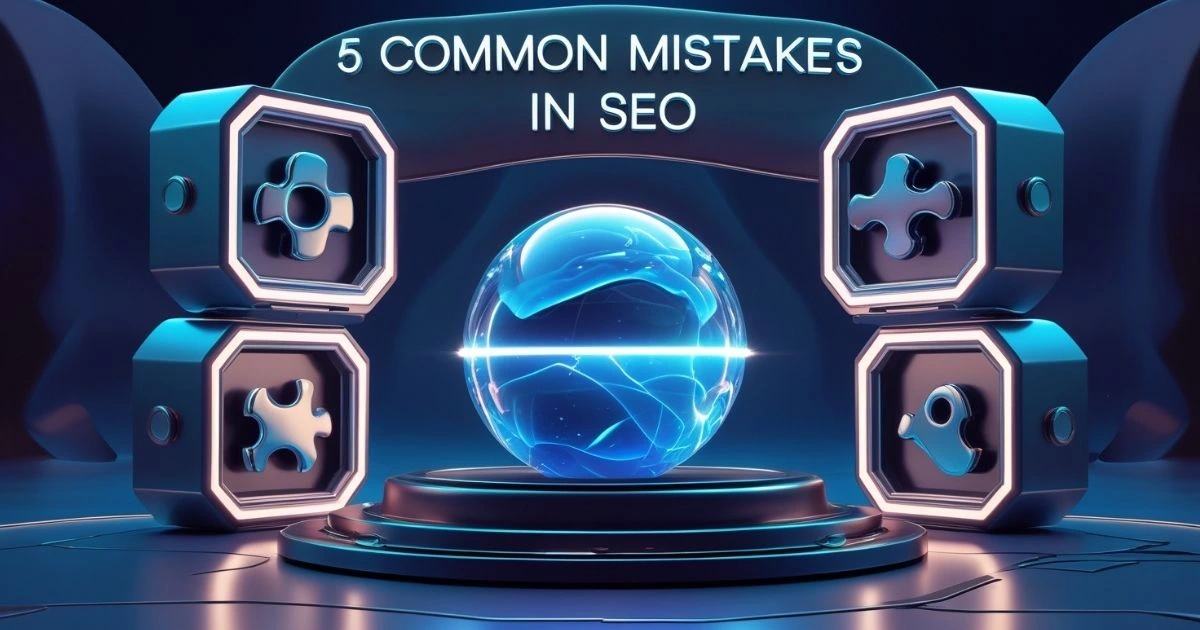Introduction
Imagine spending months building a sleek, visually stunning website for your business. You’ve invested in professional design, crafted compelling content, and launched with high expectations. But weeks go by, and your site remains buried on page 5 of Google—nowhere near your potential customers. Sound familiar?
This is a common frustration among businesses in Thailand. With over 90% of online experiences starting with a search engine, ranking on page 1 of Google is crucial for attracting customers. Yet, many companies unknowingly sabotage their own success by making critical SEO mistakes that prevent their websites from gaining visibility.
From neglecting local SEO to ignoring site speed and keyword research, these errors can cost you traffic, leads, and revenue. But the good news? Most SEO mistakes are fixable—if you know what to look for. Let’s dive into the five most common SEO mistakes that Thai businesses make and how to correct them for better rankings and growth.
1. Ignoring Local SEO Optimisation

Why This is a Problem
Many businesses in Thailand overlook the power of local SEO, assuming that general SEO tactics are enough to rank in search results. However, if your business isn’t optimised for local searches, you’re missing out on potential customers who are actively looking for services near them.
For example, if someone searches for “best coffee shop in Chiang Mai,” Google prioritises businesses with well-optimised Google My Business (GMB) profiles, local keywords, and customer reviews. If your business isn’t leveraging these elements, your competitors will appear above you—even if your coffee shop is better!
Without local SEO, your website might get lost in the sea of search results, reducing foot traffic, leads, and conversions. This is especially critical in highly competitive industries like hospitality, retail, and services, where people often search for nearby solutions.
How to Fix It
✅ Claim and Optimise Your Google My Business Profile
If you haven’t already, claim your Google My Business (GMB) listing and ensure that all details—business name, address, phone number (NAP), website, and operating hours—are correct and up to date. Add high-quality images, business descriptions, and categories that reflect your services.
✅ Use Local Keywords Strategically
Instead of targeting broad terms like “best digital agency,” use geo-specific keywords like “best digital agency in Bangkok” or “SEO consultant in Phuket.” Add these keywords to your website content, meta descriptions, and blog posts to improve rankings for local searches.
✅ Encourage Customer Reviews & Build Citations
Positive reviews boost credibility and local search rankings. Ask satisfied customers to leave reviews on your Google profile, Facebook page, and TripAdvisor (if applicable). Also, list your business on trusted Thai directories like Wongnai, Yellow Pages Thailand, and government-approved business listings.
By implementing these steps, your business will gain better visibility in local searches, driving more traffic and potential customers.
2. Poor Website Structure & Slow Loading Speed

Why This is a Problem
Have you ever clicked on a website that took forever to load? Chances are, you didn’t wait—you hit the back button and found a faster alternative. That’s exactly how potential customers react to slow-loading websites.
Many Thai businesses suffer from poor website structure, slow speeds, and unoptimised mobile experiences. These issues frustrate visitors and lead to higher bounce rates, meaning users leave without interacting.
Google also prioritises fast, mobile-friendly websites in search rankings. If your website takes longer than 3 seconds to load, you risk losing both customers and visibility on Google’s first page. And with more than 70% of internet traffic in Thailand coming from mobile devices, a website that isn’t mobile-optimised is practically invisible.
How to Fix It
✅ Run a Website Speed Audit
Start by testing your website with Google PageSpeed Insights or GTmetrix. These tools will identify slow-loading elements like large images, unoptimised code, or excessive server requests.
✅ Compress Images & Enable Caching
Large image files significantly slow down websites. Use image compression tools like TinyPNG or ShortPixel to reduce file sizes without losing quality. Additionally, enable browser caching so returning visitors can load your site faster.
✅ Use Lazy Loading & Minimise HTTP Requests
Implement lazy loading, which ensures that images and videos only load when they appear on the screen. Also, reduce unnecessary JavaScript and CSS files that slow down page rendering.
✅ Optimise for Mobile & Improve Navigation
Ensure your website is fully responsive on mobile devices. Use a clean layout, readable fonts, and intuitive navigation so users can easily find what they need. Avoid pop-ups that disrupt mobile browsing, as they can hurt your rankings.
By improving site speed and structure, you’ll enhance user experience, reduce bounce rates, and increase your chances of ranking higher on Google.
3. Not Doing Proper Keyword Research

Why This is a Problem
Many businesses in Thailand make the mistake of targeting broad, highly competitive keywords like “hotels in Bangkok” or “Thai restaurant”, only to find themselves outranked by larger, more established brands. Competing for these generic terms is a losing battle, especially for small to mid-sized businesses.
Another common mistake is keyword stuffing—forcing as many keywords as possible into a page in an unnatural way. Not only does this make content unreadable, but Google’s algorithms can penalise websites for it, pushing them even lower in rankings.
Additionally, many businesses fail to consider search intent, meaning they optimise for high-traffic keywords that don’t align with what users are actually looking for. This results in low engagement, poor conversion rates, and wasted SEO efforts.
How to Fix It
✅ Use Keyword Research Tools to Find Long-Tail Keywords
Instead of going after broad terms, use Google Keyword Planner, Ahrefs, or SEMrush to find long-tail keywords—specific phrases with lower competition but higher conversion potential. For example, instead of “best hotels in Bangkok”, try “best budget hotels near Sukhumvit”.
✅ Optimise for Search Intent, Not Just Search Volume
Ask yourself: What does the user want to achieve with this search? Someone searching “how to fix SEO mistakes” is looking for educational content, while “SEO services in Thailand” signals intent to hire an expert. Align your content with user intent to increase engagement.
✅ Naturally Integrate Keywords in Titles, Headings, and Meta Descriptions
Avoid keyword stuffing. Instead, place your primary keywords in titles, H1/H2 headings, and meta descriptions while ensuring the content flows naturally.
By refining your keyword strategy, you’ll attract the right audience, improve rankings, and increase conversions.
4. Lack of Quality Content & Blogging Strategy

Why This is a Problem
Many Thai businesses treat their websites as static online brochures, focusing only on product or service pages while neglecting blogging and content marketing. This is a huge missed opportunity.
Google rewards fresh, valuable content, meaning businesses that regularly publish high-quality blog posts are more likely to rank higher in search results. However, some companies either:
- Don’t blog at all, leaving their websites stagnant.
- Publish thin, low-quality articles that add little value.
Without a strong content strategy, businesses struggle to attract organic traffic, build authority, and engage potential customers. Worse, competitors who consistently publish helpful, optimised content will dominate the search rankings.
How to Fix
✅ Create a Content Calendar with Industry-Focused Topics
Plan and schedule SEO-optimised blog posts around relevant topics. Use tools like Google Trends, AnswerThePublic, and Ahrefs to find common industry-related questions that people are searching for.
✅ Write In-Depth, Valuable Articles with Internal Links
Instead of short, generic posts, create detailed, informative content that addresses real customer problems. For example, instead of “How to Improve SEO,” write “Step-by-Step Guide to SEO for Thai Businesses.” Also, add internal links to related articles on your site to improve SEO.
✅ Ensure Readability with Short Paragraphs, Bullet Points & Visuals
Use concise paragraphs, bullet points, and engaging images to make content easy to read. Break up large blocks of text with subheadings and infographics for better engagement.
By investing in quality content and blogging, businesses can drive consistent organic traffic, improve SEO rankings, and establish authority in their industry.
5. Failing to Track and Update SEO Efforts

Why This is a Problem
One of the biggest SEO mistakes businesses in Thailand make is treating SEO as a one-time task rather than an ongoing process. They optimise their website once, assume it’s enough, and then wonder why their rankings drop over time.
SEO is constantly evolving—Google updates its algorithms regularly, competitors improve their strategies, and user behaviour changes. If businesses don’t track their organic traffic, keyword rankings, and site health, they risk losing visibility and potential customers without even realising it.
Without consistent monitoring, businesses also miss technical issues, such as broken links, outdated content, or slow-loading pages, which can negatively impact search rankings.
How to Fix It
✅ Regularly Conduct an SEO Audit
Use tools like Google Search Console (GSC) and GA4 (Google Analytics 4) to check for indexing issues, ranking drops, and traffic trends. Audit your website every 3–6 months to ensure everything is running smoothly.
✅ Monitor Rankings, Organic Traffic, and Site Health
Track your keyword rankings using tools like Ahrefs, SEMrush, or Moz. If rankings drop, investigate possible reasons—algorithm updates, lost backlinks, or competitors outranking you.
✅ Continuously Update Old Content & Adapt to Algorithm Changes
Keep blog posts and pages fresh and relevant by updating statistics, adding new insights, and improving readability. Stay informed about Google algorithm updates and adjust your SEO strategy accordingly.
By consistently tracking and updating SEO efforts, businesses can stay ahead of competitors and maintain strong search visibility over time.
Conclusion & Call to Action
Avoiding these common SEO mistakes can mean the difference between ranking on page 1 of Google or getting lost in the search results. By optimising for local SEO, improving website speed, using proper keyword research, investing in quality content, and tracking SEO efforts, businesses in Thailand can boost their online visibility and attract more customers.
Now, it’s time to take action. When was the last time you checked your SEO performance? If you’re unsure whether your website is fully optimised, it’s time to conduct a comprehensive SEO audit.
🚀 Get Started Today! 🚀
🔹 Download our FREE SEO Checklist to identify quick fixes.
🔹 Or book a free consultation with our SEO experts to get a tailored strategy for your business.
Don’t let these mistakes hold your website back—take control of your rankings today!
FAQs
Mistake: Ignoring Local SEO & Google My Business (GMB)
Why It’s Hurting You: 80% of Thai searches include local intent. Unoptimized GMB listings lose 50%+ visibility.
Fixes (2025):
- ✅ Claim & complete your GMB profile (Thai + English, photos, “Open Now”).
- ✅ Embed Google Maps for local relevance.
- ✅ Get reviews in Thai with local keywords (e.g., “ร้านกาแฟที่ดีที่สุดในกรุงเทพ”).
- ✅ Use
LocalBusinessschema markup.
Mistake: Not Checking for SEO Errors (Technical & Content)
Why It’s Hurting You: Broken links, poor speed, and AI content penalties degrade rankings.
Fixes (2025):
- ✅ Use Google Search Console + Screaming Frog for audits.
- ✅ Optimize mobile speed (WebP, lazy loading, Thai servers).
- ✅ Use Originality.ai to identify and rewrite low-quality AI content.
Mistake: Expecting Overnight Fixes
Why It’s Hurting You: SEO requires time and E-E-A-T signals to rank well.
Fix Strategy (2025):
- 1–7 Days: Fix 404s, meta tags, mobile UX.
- 1–3 Months: Build Thai backlinks, optimize topic clusters.
- 6+ Months: Earn .th links from Thai media (Sanook, The Nation).
Mistake: Blogging Without Strategy
Why It’s Hurting You: Generic listicles no longer perform—Google prioritizes depth & value.
Fixes (2025):
- ✅ Target pain point queries (e.g., “วิธีแก้ปัญหา [industry] ในไทย”).
- ✅ Add TikTok/YouTube Shorts with Thai subtitles.
- ✅ Translate content (DeepL) for Thai + English reach.
Mistake: “Set and Forget” SEO
Why It’s Hurting You: Static sites fall behind in Google’s AI-dominated SERPs.
Fixes (2025):
- ✅ Weekly GMB updates and quarterly site refreshes.
- ✅ Monitor “People Also Ask” boxes and featured snippets.
- ✅ Voice search optimization (e.g., “ร้านอาหารอิตาลีที่ไหนดี”).
[BONUS] 2025’s Biggest SEO Opportunity – Video SEO
Why It Matters: 50% of Thai searches include video results.
Action Steps:
- 📹 Upload Thai-subtitled tutorials to YouTube.
- 📄 Embed videos with schema in blogs.
- 📱 Share Shorts that link to your site.


